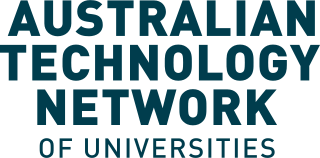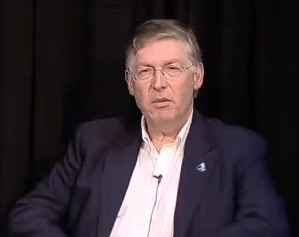
Steven Tingay is a John Curtin Distinguished Professor at Curtin University and deputy executive director of the International Centre for Radio Astronomy Research. He is a specialist in radio astronomy and astrophysics. [1] [2]

Steven Tingay is a John Curtin Distinguished Professor at Curtin University and deputy executive director of the International Centre for Radio Astronomy Research. He is a specialist in radio astronomy and astrophysics. [1] [2]

The University of Western Australia (UWA) is a public research university in the Australian state of Western Australia. The university's main campus is in Crawley, a suburb located in the City of Perth local government area. UWA was established in 1911 by an act of the Parliament of Western Australia.

Curtin University is an Australian public research university based in Bentley, Perth, Western Australia. It is named after John Curtin, Prime Minister of Australia from 1941 to 1945, and is the largest university in Western Australia, with 58,607 students in 2022.

The Australian Technology Network (ATN) is a network of six Australian universities, with a strong history of innovation, enterprise and working closely with industry. ATN traces its origins back to 1975 as the Directors of Central Institutes of Technology (DOCIT), and was revived in 1999 in its present form with changes to its membership announced in 2018, 2020, 2021 and 2023.

Professor Peter Quinn is Executive Director of the International Centre for Radio Astronomy Research (ICRAR) in Perth, Western Australia and was previously the Head of the Data Management and Operations Division at the European Southern Observatory (ESO) in Munich.

The Murchison Widefield Array (MWA) is a joint project between an international consortium of organisations to construct and operate a low-frequency radio array. 'Widefield' refers to its very large field of view. Operating in the frequency range 70–300 MHz, the main scientific goals of the MWA are to detect neutral atomic Hydrogen emission from the cosmological Epoch of Reionization (EoR), to study the Sun, the heliosphere, the Earth's ionosphere, and radio transient phenomena, as well as map the extragalactic radio sky. It is located at the Murchison Radio-astronomy Observatory (MRO).

Curtin University Malaysia is the Malaysian campus of Curtin University, a public university based in Australia. It is the university's largest campus outside of Australia with a total area of 1,200-hectare (3,000-acre) comprising academic and residential blocks. It offers undergraduate and postgraduate programs in various fields of commerce, engineering, computational sciences, humanities and health sciences. It also offers foundational courses and a Doctor of Philosophy (PhD) among other higher degree by research programs. It is named after John Curtin, a prominent Prime Minister of Australia during World War II from 1941 to 1945.

Macarthur Astronomy Forum is a monthly public forum organised by Macarthur Astronomical Society, providing leading national and international professional astronomers with a platform to address the Forum on topics of astronomical interest; also providing members of the Society and the general public with opportunities to learn and ask questions.
ARC Centre of Excellence for All-Sky Astrophysics was a collaboration of international astronomers dedicated to wide field astronomy. It was formally launched on 12 September 2011, at Sydney Observatory and ceased in 2018.

Curtin Mauritius is the Mauritian campus of Curtin University, a public university in Australia. It offers undergraduate and postgraduate degree programs in healthcare, information technology, commerce, design and communications. Curtin University is named after John Curtin, a prominent Prime Minister of Australia during World War II from 1941 to 1945, and is the largest university in the state of Western Australia with 58,607 students globally in 2022. It is the only Australian university campus in Africa and was formally opened on 3 May 2018 by Pravind Jugnauth, the prime minister of Mauritius.
The International Centre for Radio Astronomy Research (ICRAR) is an international "centre of excellence" in astronomical science and technology based in Perth, Western Australia, launched in August 2009 as a joint venture between Curtin University and the University of Western Australia. The ICRAR attracts researchers in radio astronomy, contributing to Australian and international scientific and technical programs for the international Square Kilometre Array (SKA) project, the world's biggest ground-based telescope array which is in its design phase and the two Australian SKA precursors, the Australian Square Kilometre Array Pathfinder (ASKAP) and the Murchison Widefield Array (MWA), both located in Murchison. The headquarters of the ICRAR is located in Crawley.

theSkyNet was a research project that used volunteer Internet-connected computers to carry out research in astronomy. It was an initiative of the International Centre for Radio Astronomy Research (ICRAR), a joint venture of Curtin University and the University of Western Australia. theSkyNet had two projects, Sourcefinder and POGS. Both projects have been completed. theSkyNet Sourcefinder aimed to test and refine automatic radio sourcefinding algorithms in preparation for radio galaxy surveys using the Australian Square Kilometre Array Pathfinder and the Square Kilometre Array. theSkyNet POGS used Spectral Energy Distribution fitting to calculate characteristics of many galaxies using images taken by the Pan-STARRS PS1 optical telescope in Hawaii.
Elaine Margaret Sadler is an Australian astrophysicist. She is the Australia Telescope National Facility Chief Scientist and a Professor of Astrophysics in the School of Physics at the University of Sydney. She was elected as a fellow of the Australian Academy of Science (AAS) in 2010 and commenced a 4-year term as Foreign Secretary of the AAS in 2018. She was previously director of the CAASTRO centre (2014-2018).
Peter A. Curran was an Irish astronomer, known for his work on gamma-ray bursts, stellar black holes and the Peter Curran Award.
David Bruce Davidson is a London-born South African electrical engineer at Curtin University, Perth, Western Australia whose work started in the field of Computational Electromagnetics focussed on the underlying theory and engineering applications of, in particular, finite element methods. In 2012 he was named Fellow of the Institute of Electrical and Electronics Engineers (IEEE) for contributions to computational electromagnetics. He currently leads the engineering team at the Curtin Institute of Radio Astronomy, part of the International Centre for Radio Astronomy Research (ICRAR). His current research interests include computational electromagnetics and engineering electromagnetics for radio astronomy.

Melanie Johnston-Hollitt is an Australian astrophysicist and professor. She has worked on the design, construction, and international governance of several radio telescopes including the Low Frequency Array (LOFAR), the Murchison Widefield Array (MWA) and the upcoming Square Kilometre Array (SKA). She was the director of the Murchison Widefield Array until December 2020 and is a professor at the Curtin Institute of Radio Astronomy at Curtin University and the International Centre for Radio Astronomy Research. Since August 2020, Melanie Johnston-Hollitt is the director of the Curtin Institute for Data Science.
Simon Ellingsen is an Executive Director of the International Centre for Radio Astronomy Research (ICRAR) and is based at the University of Western Australia node
GLEAM-X J162759.5-523504.3 is a transient astronomical radio source, found in 2020, in archival data recorded in 2018 by the Murchison Widefield Array.
Virginia Kilborn is a professor and radio astronomer with the Centre for Astrophysics and Supercomputing at Swinburne University and is Swinburne's first Chief Scientist. She researches galaxy evolution by studying their gas content and is working on the surveys of the next generation of radio telescopes, including the Australian SKA Pathfinder.